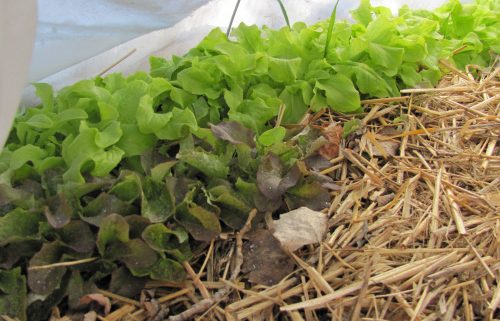 As winter slowly slips in we are starting to transition into the internal senescence of the season. The leaves are falling, blanketing the world and garden for a rest. As a human being I too will rest, though I continue to eat all winter long and love to provide at least a little fresh food for my family. I believe in letting go, but I also like to hang on, just a little. The key is just consolidating so you can conserve your resources and maximum energy in all forms. Here are some of my secrets for high desert winter food production.
As winter slowly slips in we are starting to transition into the internal senescence of the season. The leaves are falling, blanketing the world and garden for a rest. As a human being I too will rest, though I continue to eat all winter long and love to provide at least a little fresh food for my family. I believe in letting go, but I also like to hang on, just a little. The key is just consolidating so you can conserve your resources and maximum energy in all forms. Here are some of my secrets for high desert winter food production.
PLAN THE GARDEN
Timing is what makes a winter garden. Planting your winter vegetables in August will ensure good hardy plants that you can protect and keep harvesting off into the winter.
Planning ahead is what winter gardening is all about.
If you got a late start, transplanting can be done into the fall, but don’t expect much growth until spring.
Your plants will most likely live, but may not thrive until spring, however they will have such a head start that you will be eating from them when it is technically still winter, most likely in March.
PLANT
 You can still plant perennials in the fall and early winter. October is a beautiful month to plant, garlic, bulbs like tulip and daffodils, perennials and fruit trees. Plus, most nurseries have big sales on perennials.
You can still plant perennials in the fall and early winter. October is a beautiful month to plant, garlic, bulbs like tulip and daffodils, perennials and fruit trees. Plus, most nurseries have big sales on perennials.
Perennials will need to be watered in the winter, but no more than a good watering every three weeks (unless they are covered in snow and then you get the day off!). In the spring they will have a beautifully established root system and be stronger against harsh spring conditions.
As for seeds, I honestly do not plant any seeds from Fall Equinox to Winter Solstice. Remember, mother nature needs to rest too. If you do have ways to cover your beds or have cold frames, established plants, or even starts can be covered of put in cold frames in the fall. After November 15th though, I would probably hold off until February for this too, as it is really hard for seeds to go through transplanting shock in the cold season.
GATHER ORGANIC MATTER
Building soil and adding organic material is our main goal as gardeners, especially here in New Mexico. Learning wild foods is, of course, crucial, but if we want to eat cucumbers originally from India and lettuce from the Fertile Crescent, we must provide the tilth and nutrients needed for these delicacies. To do this we must gather, save and cycle as much organic material as we possibly can into our systems
COLLECT LEAVES
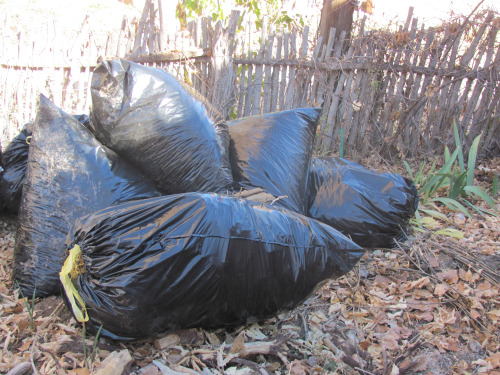 Use leaves for mulching beds, making compost and for general building organic material on your site. Bags are lining the streets right now, you have a trunk in your car, right? Mine get delivered to my front yard; after years of living under the same big tree my neighbor and I have figured out the perfect harmony. He rakes the leaves that fall in his yard, bags them up and throws them over the fence into my yard. I dump them out onto my beds and give him back the bags to reuse!!
Use leaves for mulching beds, making compost and for general building organic material on your site. Bags are lining the streets right now, you have a trunk in your car, right? Mine get delivered to my front yard; after years of living under the same big tree my neighbor and I have figured out the perfect harmony. He rakes the leaves that fall in his yard, bags them up and throws them over the fence into my yard. I dump them out onto my beds and give him back the bags to reuse!!
KEEP AND USE EGG SHELLS
 Every time you crack an egg put it on a cookie sheet in the oven, the pilot will dry them out and when the sheet is full they can be crushed to a powder and saved in a mason jar for calcium amending later. My son, Jaengy, helps me by smashing the toasted eggshells in the clay mortar and pestle (above). I have found them very effective in preventing blossom end root in my tomatoes. Last year I saved a gallon full and it turned out to be perfect for 100 tomato plants, one handful per plant. Since tomato planting time ( May) I have already gathered almost a gallon…luckily there are some other amazing uses for eggshells.
Every time you crack an egg put it on a cookie sheet in the oven, the pilot will dry them out and when the sheet is full they can be crushed to a powder and saved in a mason jar for calcium amending later. My son, Jaengy, helps me by smashing the toasted eggshells in the clay mortar and pestle (above). I have found them very effective in preventing blossom end root in my tomatoes. Last year I saved a gallon full and it turned out to be perfect for 100 tomato plants, one handful per plant. Since tomato planting time ( May) I have already gathered almost a gallon…luckily there are some other amazing uses for eggshells.
FERTILIZE WITH COFFEE GROUNDS
The sweetest smelling soft country roses grows outside my front door. I attribute the sweet smell to the coffee grounds I use to fertilize them.
Coffee grounds are great for acid loving roses. They can be applied directly to the soil around the rose during the year, or you can add them to your compost system. Worms love them too!
If you garden and don’t have a compost, start one.
You will be amazed at how much less garbage leaves your house and you won’t have to worry about stinky, leaky garbage bags anymore.
I usually start a new pile of compost every spring, so that by fall the old one is fully decomposed and can be harvested.
Making compost where you would like to have a garden the next year is ideal, as the soil is being worked and amended for you.
MAKE COMPOST
 Take the compost from the chicken shed, the worm pile or just the plain old compost pile. To harvest the compost I usually take off the top ‘cap’ of leaves or straw (used to keep moisture in a pile and keep in any smell), dig out the ready compost and pass it through a shifter over a wheelbarrow (see below).
Take the compost from the chicken shed, the worm pile or just the plain old compost pile. To harvest the compost I usually take off the top ‘cap’ of leaves or straw (used to keep moisture in a pile and keep in any smell), dig out the ready compost and pass it through a shifter over a wheelbarrow (see below).
If the compost has sat all summer, it is probably ready to use, though sifting gets out any bigger pieces that have not decomposed and which then can be added to the new pile. Shifting also gets out the worms so they can be added to a new pile.
Sprinkle your garden beds with about an inch of compost and turn the compost in a bit. By harvesting compost now you also can store it in a container so you have it on hand for potting mix in the late winter. Trust me, do not wait until January to harvest compost—you will never do it again!
TURN THE SOIL
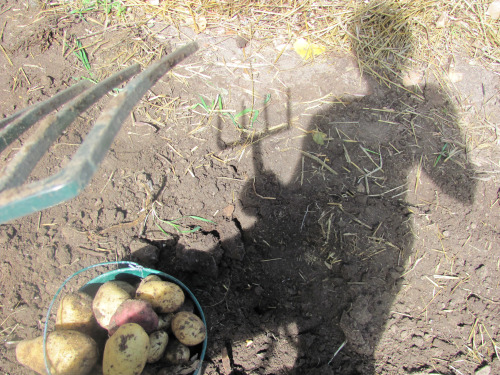 You can turn the soil with a pitch fork or a broad fork, which multiplies your efforts, and can be bought locally here. If the compost has fresh manure in it, it will break down and leach over the winter and should be plenty safe for spring planting. Fall is a great time to dig, fork or loosen beds, as the soil is warm and often moist from the fall rains. If you wait till spring, the ground may be frozen when you are ready to plant your early crops. Perennial crops do not need tilling, and do not prefer it, but annuals do seem to respond best to lightly fluffed soil with good titlth (texture) and well broken down organic material so nitrogen isn’t robbed in the process of decomposing other things.
You can turn the soil with a pitch fork or a broad fork, which multiplies your efforts, and can be bought locally here. If the compost has fresh manure in it, it will break down and leach over the winter and should be plenty safe for spring planting. Fall is a great time to dig, fork or loosen beds, as the soil is warm and often moist from the fall rains. If you wait till spring, the ground may be frozen when you are ready to plant your early crops. Perennial crops do not need tilling, and do not prefer it, but annuals do seem to respond best to lightly fluffed soil with good titlth (texture) and well broken down organic material so nitrogen isn’t robbed in the process of decomposing other things.
APPLY MULCH
Once you’ve turned the soil where appropriate, apply a heavy mulch to the ground. Heavy mulching really helps retain moisture, keeps the soil a bit warmer, as well as suppresses weeds in spring and builds organic material. Leaves & aged straw, are my favorites and are usually free.
Cleaning, composting, turning and mulching a bed in the winter helps for early spring planting. Once you do all these steps in the fall when the weather is still lovely, your beds are ready for early spring planting. You need not spend too much time out on the April wind chipping at frozen ground.
COVER YOUR ROWS
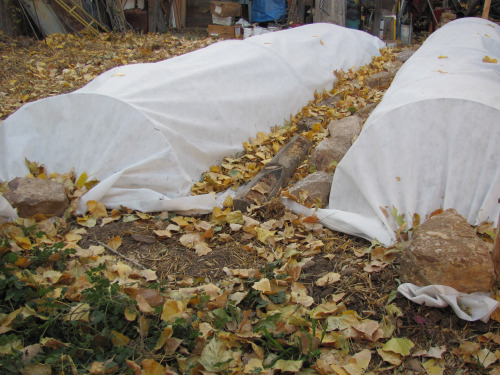 I often will cover up my fall crops with row cover in late September before the first frosts, but most of the listed crops below are cold hardy and can take a few light freezes, so they can be ignored for a bit while you focus on rescuing the summer crops from the cold.
I often will cover up my fall crops with row cover in late September before the first frosts, but most of the listed crops below are cold hardy and can take a few light freezes, so they can be ignored for a bit while you focus on rescuing the summer crops from the cold.
First you make little hoops from nine-gauge wire that you can buy in a spool from the hardware store. Next, cut three to four food pieces of the wire and bend them into half circles. Stick these in the ground about every three feet and then wrap with your row cover.
I get the heavy weight floating row cover from Plants of the Southwest for $3.50 a yard. It is 12 feet wide so you can cut pieces that fit over your beds. Remember to leave extra space on the edges so that it can be well weighted down by soil or stones; any strong breeze that catches under the covers will create a sail affect which could tear or remove your covers altogether.
LET THE SUNSHINE IN
 Once I do cover my beds, I cover them for good, as to protect them from wind, and cold. It is important for the air to move freely, so no need to open and close them every day. The fabric also keeps in moisture and with cooler temps you need to water less. When I do open them up, I do it in the hot part of the day, as some plants actually freeze and thaw in the cold season.
Once I do cover my beds, I cover them for good, as to protect them from wind, and cold. It is important for the air to move freely, so no need to open and close them every day. The fabric also keeps in moisture and with cooler temps you need to water less. When I do open them up, I do it in the hot part of the day, as some plants actually freeze and thaw in the cold season.
Winter watering will need to be done, just like summer watering. When you scratch the surface of the soil and stick your finger in and the soil is dry a fingers depth, you should water, unless of course the soil is frozen. I usually water my in-ground garden beds every three weeks in the winter. Snow is a great thing for your veggies and there is no need to water if there is snow on the ground, just remember it also may not be the best time to harvest your plants.
SELECT COOL SEASON CROPS
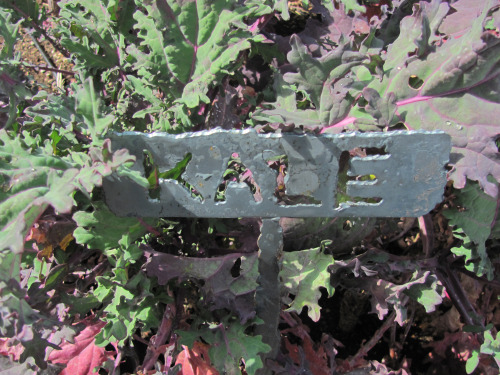 Winter gardening really just means keeping alive summer and fall crops. Winter gardening for me starts in August when I start planting my fall crops. It can also mean prepping the soil in fall, heating it up early in the spring with cold frames and planting in late winter or early spring.
Winter gardening really just means keeping alive summer and fall crops. Winter gardening for me starts in August when I start planting my fall crops. It can also mean prepping the soil in fall, heating it up early in the spring with cold frames and planting in late winter or early spring.
In New Mexico, before or during the monsoon season is the ideal time for planting fall crops because the soil opens up and receives the rains and so do your seeds. The moisture and cooling this season brings is great for fall crops and the plants thrive in the lessening light.
Choosing cold hardy varieites is key to a hardy winter garden. In his book Four Season Harvest Eliot Coleman lists all his winter varieties and most seed companies now have lists of cold hardy crops.
KNOW YOUR HARDY PLANTS
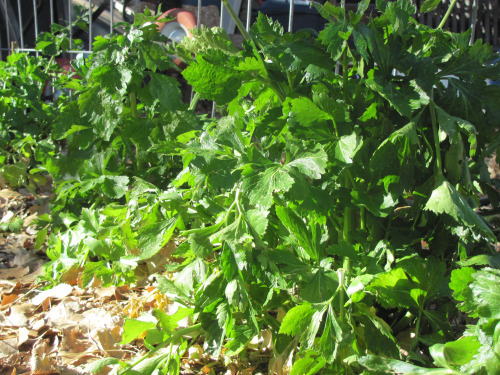 When you do open up your beds, do it mid day, as the plant will enjoy the sun and may even be somewhat frozen. If you harvest the plant like this it will turn to mush, but if you wait till it thaws it will be fine! It is kind of amazing to watch during the day. I have neglected to cover my chard and while it looks totally dead in the morning, by the afternoon it is perky again and ready to harvest. Different vegetables have different cold tolerances which are useful to know.
When you do open up your beds, do it mid day, as the plant will enjoy the sun and may even be somewhat frozen. If you harvest the plant like this it will turn to mush, but if you wait till it thaws it will be fine! It is kind of amazing to watch during the day. I have neglected to cover my chard and while it looks totally dead in the morning, by the afternoon it is perky again and ready to harvest. Different vegetables have different cold tolerances which are useful to know.
The hardiest of the winter vegetables are Kale, Collards and Spinach which can take temperatures as low as the low 20’s to the high teens.
Broccoli, Brussel Sprouts, Cabbage, Kohlrabi, Mustard Greens, Parsley, Radish, Parsnip, and Turnip can all take temperatures from 25 to 28 degrees.
All of these can survive under thick row cover all winter. Though they may not show many signs of growth, they will start to spring new leaves in February.
Other semi-hardy vegetables are Beets, Carrots, Cauliflower, Celery, Chinese Cabbage, Endive, Lettuce, Radicchip, Rutabaga, Salsify, Bok Choy, Tatsoi and Swiss Chard, which are tolerant of temperatures from 29 to 32 degrees. These crops can usually be harvested until Christmas under heavy row cover, but will need to be replanted in the spring under row cover as well.
MAKE A COLD FRAME
 Cold frames can be built in all kind of ways and there are some great designs out there you can easily be guided by. I would start by reading Eliot Coleman’s books. There are glass, plastic, straw bale, adobe and even some pretty sweet custom made ones by our local Grow Your Own veggie man, Ken Kuhn.
Cold frames can be built in all kind of ways and there are some great designs out there you can easily be guided by. I would start by reading Eliot Coleman’s books. There are glass, plastic, straw bale, adobe and even some pretty sweet custom made ones by our local Grow Your Own veggie man, Ken Kuhn.
I love cold frames and could talk forever about them. But the first thing to think about is your winter reality. How much do you really need? How much are you really willing to do? How far are you willing to go? I recommend finding a nice south facing nook close to your front doorstep where you can reach out in your bathrobe and slippers, raise a lid and snip a few fresh leaves on a cold winter day. Now doesn’t that seem nice? I wrote a whole post on making those greens last.
STAY TUNED FOR SPRING
So hopefully all this should get you started. Stay tuned for my “Late Winter in the Garden” post in a couple of months when you and nature are really ready to get growing again.
…………………………………………………………………………………………………………………………
 From early experiences Erin O’Neill learned that feeding your family and teaching your children are most worthy and sustainable goals. Erin has lived on a small plot in Northern New Mexico, that she and her family help nurture and bloom, for 13 years. She has focused her career on educational gardens at the Santa Fe Children’s Museum, Monte Del Sol Charter School and now at the Santa Fe Community College. Her love of gardening is her most cherished gift and she always delights in sharing it. Enjoy more of Erin’s writing and photography at Seeds & Stones.
From early experiences Erin O’Neill learned that feeding your family and teaching your children are most worthy and sustainable goals. Erin has lived on a small plot in Northern New Mexico, that she and her family help nurture and bloom, for 13 years. She has focused her career on educational gardens at the Santa Fe Children’s Museum, Monte Del Sol Charter School and now at the Santa Fe Community College. Her love of gardening is her most cherished gift and she always delights in sharing it. Enjoy more of Erin’s writing and photography at Seeds & Stones.
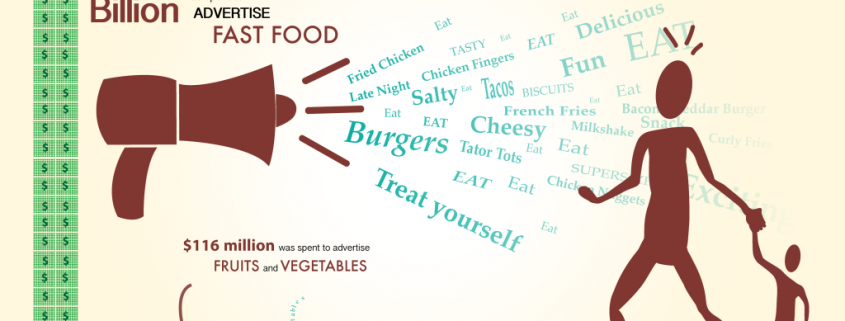
 Peggy O’Mara is the CEO of peggyomara.com. She was the editor and publisher of Mothering from 1980 to 2011. The author of Having a Baby Naturally; Natural Family Living; The Way Back Home; and A Quiet Place, Peggy has conducted workshops at Omega Institute, Esalen, La Leche League, and Bioneers. She is the mother of four and grandmother of two and has lived in Santa Fe since 1984.
Peggy O’Mara is the CEO of peggyomara.com. She was the editor and publisher of Mothering from 1980 to 2011. The author of Having a Baby Naturally; Natural Family Living; The Way Back Home; and A Quiet Place, Peggy has conducted workshops at Omega Institute, Esalen, La Leche League, and Bioneers. She is the mother of four and grandmother of two and has lived in Santa Fe since 1984.


 As winter slowly slips in we are starting to transition into the internal senescence of the season. The leaves are falling, blanketing the world and garden for a rest. As a human being I too will rest, though I continue to eat all winter long and love to provide at least a little fresh food for my family. I believe in letting go, but I also like to hang on, just a little. The key is just consolidating so you can conserve your resources and maximum energy in all forms. Here are some of my secrets for high desert winter food production.
As winter slowly slips in we are starting to transition into the internal senescence of the season. The leaves are falling, blanketing the world and garden for a rest. As a human being I too will rest, though I continue to eat all winter long and love to provide at least a little fresh food for my family. I believe in letting go, but I also like to hang on, just a little. The key is just consolidating so you can conserve your resources and maximum energy in all forms. Here are some of my secrets for high desert winter food production. You can still plant perennials in the fall and early winter. October is a beautiful month to plant, garlic, bulbs like tulip and daffodils, perennials and fruit trees. Plus, most nurseries have big sales on perennials.
You can still plant perennials in the fall and early winter. October is a beautiful month to plant, garlic, bulbs like tulip and daffodils, perennials and fruit trees. Plus, most nurseries have big sales on perennials. Use leaves for mulching beds, making compost and for general building organic material on your site. Bags are lining the streets right now, you have a trunk in your car, right? Mine get delivered to my front yard; after years of living under the same big tree my neighbor and I have figured out the perfect harmony. He rakes the leaves that fall in his yard, bags them up and throws them over the fence into my yard. I dump them out onto my beds and give him back the bags to reuse!!
Use leaves for mulching beds, making compost and for general building organic material on your site. Bags are lining the streets right now, you have a trunk in your car, right? Mine get delivered to my front yard; after years of living under the same big tree my neighbor and I have figured out the perfect harmony. He rakes the leaves that fall in his yard, bags them up and throws them over the fence into my yard. I dump them out onto my beds and give him back the bags to reuse!! Every time you crack an egg put it on a cookie sheet in the oven, the pilot will dry them out and when the sheet is full they can be crushed to a powder and saved in a mason jar for calcium amending later. My son, Jaengy, helps me by smashing the toasted eggshells in the clay mortar and pestle (above). I have found them very effective in preventing blossom end root in my tomatoes. Last year I saved a gallon full and it turned out to be perfect for 100 tomato plants, one handful per plant. Since tomato planting time ( May) I have already gathered almost a gallon…luckily there are some other
Every time you crack an egg put it on a cookie sheet in the oven, the pilot will dry them out and when the sheet is full they can be crushed to a powder and saved in a mason jar for calcium amending later. My son, Jaengy, helps me by smashing the toasted eggshells in the clay mortar and pestle (above). I have found them very effective in preventing blossom end root in my tomatoes. Last year I saved a gallon full and it turned out to be perfect for 100 tomato plants, one handful per plant. Since tomato planting time ( May) I have already gathered almost a gallon…luckily there are some other  Take the compost from the chicken shed, the worm pile or just the plain old compost pile. To harvest the compost I usually take off the top ‘cap’ of leaves or straw (used to keep moisture in a pile and keep in any smell), dig out the ready compost and pass it through a shifter over a wheelbarrow (see below).
Take the compost from the chicken shed, the worm pile or just the plain old compost pile. To harvest the compost I usually take off the top ‘cap’ of leaves or straw (used to keep moisture in a pile and keep in any smell), dig out the ready compost and pass it through a shifter over a wheelbarrow (see below). You can turn the soil with a pitch fork or a broad fork, which multiplies your efforts, and can be bought locally
You can turn the soil with a pitch fork or a broad fork, which multiplies your efforts, and can be bought locally  I often will cover up my fall crops with row cover in late September before the first frosts, but most of the listed crops below are cold hardy and can take a few light freezes, so they can be ignored for a bit while you focus on rescuing the summer crops from the cold.
I often will cover up my fall crops with row cover in late September before the first frosts, but most of the listed crops below are cold hardy and can take a few light freezes, so they can be ignored for a bit while you focus on rescuing the summer crops from the cold. Once I do cover my beds, I cover them for good, as to protect them from wind, and cold. It is important for the air to move freely, so no need to open and close them every day. The fabric also keeps in moisture and with cooler temps you need to water less. When I do open them up, I do it in the hot part of the day, as some plants actually freeze and thaw in the cold season.
Once I do cover my beds, I cover them for good, as to protect them from wind, and cold. It is important for the air to move freely, so no need to open and close them every day. The fabric also keeps in moisture and with cooler temps you need to water less. When I do open them up, I do it in the hot part of the day, as some plants actually freeze and thaw in the cold season. Winter gardening really just means keeping alive summer and fall crops. Winter gardening for me starts in August when I start planting my fall crops. It can also mean prepping the soil in fall, heating it up early in the spring with cold frames and planting in late winter or early spring.
Winter gardening really just means keeping alive summer and fall crops. Winter gardening for me starts in August when I start planting my fall crops. It can also mean prepping the soil in fall, heating it up early in the spring with cold frames and planting in late winter or early spring. When you do open up your beds, do it mid day, as the plant will enjoy the sun and may even be somewhat frozen. If you harvest the plant like this it will turn to mush, but if you wait till it thaws it will be fine! It is kind of amazing to watch during the day. I have neglected to cover my chard and while it looks totally dead in the morning, by the afternoon it is perky again and ready to harvest. Different vegetables have different cold tolerances which are useful to know.
When you do open up your beds, do it mid day, as the plant will enjoy the sun and may even be somewhat frozen. If you harvest the plant like this it will turn to mush, but if you wait till it thaws it will be fine! It is kind of amazing to watch during the day. I have neglected to cover my chard and while it looks totally dead in the morning, by the afternoon it is perky again and ready to harvest. Different vegetables have different cold tolerances which are useful to know. Cold frames can be built in all kind of ways and there are some great designs out there you can easily be guided by. I would start by reading Eliot Coleman’s books. There are glass, plastic, straw bale, adobe and even some pretty sweet custom made ones by our local
Cold frames can be built in all kind of ways and there are some great designs out there you can easily be guided by. I would start by reading Eliot Coleman’s books. There are glass, plastic, straw bale, adobe and even some pretty sweet custom made ones by our local  From early experiences Erin O’Neill learned that feeding your family and teaching your children are most worthy and sustainable goals. Erin has lived on a small plot in Northern New Mexico, that she and her family help nurture and bloom, for 13 years. She has focused her career on educational gardens at the Santa Fe Children’s Museum, Monte Del Sol Charter School and now at the Santa Fe Community College. Her love of gardening is her most cherished gift and she always delights in sharing it. Enjoy more of Erin’s writing and photography at
From early experiences Erin O’Neill learned that feeding your family and teaching your children are most worthy and sustainable goals. Erin has lived on a small plot in Northern New Mexico, that she and her family help nurture and bloom, for 13 years. She has focused her career on educational gardens at the Santa Fe Children’s Museum, Monte Del Sol Charter School and now at the Santa Fe Community College. Her love of gardening is her most cherished gift and she always delights in sharing it. Enjoy more of Erin’s writing and photography at